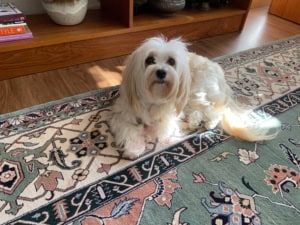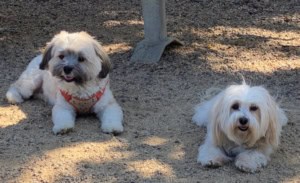The Havanese – A Vision in Perfection
By Joni Johnson

STARR: A three-year old Havanese
OK- I’m taking advantage of being at the beginning of this Great Adventure- THE COMPLEMENT!
I admit that Starr is my dog. She weighs 10 pounds and will be four years old in early November. Before Starr, our family was a family of Golden Retrievers (a 35 year string). We had no idea we would ever end up with such a little dog. After our last Golden died in 2007, we decided we would do some serious traveling and managed to survive without a dog for ten years. But it was close to impossible. After 10 years with no dog and knee problems of our own, we babysat a six month old golden for 3 days in 2017. We clearly realized we were ready for a smaller dog.
That is when we started our research on the internet. This is what we found:
The Havanese
The Havanese is a small, sturdy, short-legged dog with a unique gait that is exceptionally lively and springy, accentuating the dog’s happy nature. This is because its front legs are shorter than its back legs which creates a look like a hopping rabbit when running. The coat is double, with both under and outer coat soft. The profuse outer coat is very long, reaching 6 to 8 inches in length, and ranges from straight to curly, with wavy preferred. The curly coat is allowed to cord. The Havanese has a gentle expression.
History
The Havanese is one of the Barbichon (later shortened to Bichon) family of small dogs originating in the Mediterranean in ancient times. Spanish traders brought some of these dogs with them as gifts for Cuban women, allowing them to establish trading relationships. In Cuba, the little dogs were pampered as the special pets of the wealthy. They became known as Habeneros, and eventually some found their way back to Europe where they were called the White Cuban. They became quite popular, not only as pets of the elite but also as performing dogs. Their popularity as pets waned, however, and their stronghold remained in the circus, where they performed throughout Europe as trick dogs. Eventually the breed declined in numbers to such an extent that it was almost extinct not only in Europe but also in its native Cuba. A few remained in Cuba, however, and three families with their Havanese left Cuba for the United States during the 1950s and 1960s. Most present-day Havanese descend from these dogs. It has gradually aroused attention from dog fanciers and pet owners, and in 1996 the first Havanese entered an AKC show ring, and was accepted for regular recognition as a member of the Toy Group as of the first day of 1999. The Havanese is also known as the Havana Silk Dog.
Temperament
This is a busy, curious dog, happiest when residing at the center of attention of the family. The Havanese loves to play and clown and is affectionate to family, children, strangers, other dogs, and pets—basically everyone! This breed is willing to please, learns easily, and can tend to be vocal.
Upkeep

Seamus and Starr
Although energetic, the exercise needs of the Havanese can be met with a short walk or a good play session. Coat care entails a full brushing two to four times a week. This is a non-shedding dog. Loose hairs are caught in the outer hairs, tending to tangle, unless they are combed out regularly.
Havanese on Campus

Ginger
Well, after some meet and greets, we were sold, and Starr became part of our family at the age of 10 weeks. She’s a wonderful dog. We chose her breed because of her reputation for friendliness to both people and other animals. And of course, after 35 years of Golden Retrievers, we especially liked her because she doesn’t shed.
There are two other Havanese on campus. You may have met them. One is named Seamus and belongs to Kathy and Patrick Perkins on the west side of RVM. He will be two this September and comes from Astoria, Oregon. The second belongs to Jack Wellinger on the east side of the campus. Ginger is the largest of the three dogs, four years old and a beautiful red brown color. If you ask their owners what they love most about their dogs, they would say how smart they are and how friendly they are to everyone- large and small.
What Do You Think
Well, this is your time to tell us what you think. Would you like more stories about pets on campus? Let us know.




Sure! Love ’em all!
I love your sweet Havanese fur baby, Starr, and our (brother and sister) Tonkinese cats, Koko and Kiki. Pets become a special part of our families. Enjoyed reading your articles! Lynne B.